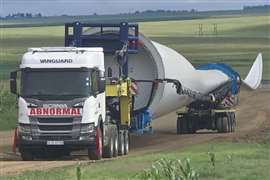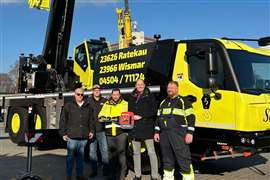Read this article in French German Italian Portuguese Spanish
Powering tower cranes for less money with lower pollution
30 July 2025
Dr Andrew Deakin discusses different technologies and challenges for more efficiently powering tower cranes. Alex Dahm reports
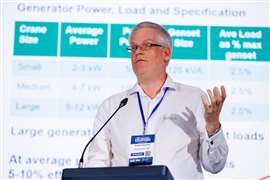 Dr Andrew Deakin giving his insight into the different technologies and challenges of more efficiently powering tower cranes. Photo: Joe Mather/KHL
Dr Andrew Deakin giving his insight into the different technologies and challenges of more efficiently powering tower cranes. Photo: Joe Mather/KHL
Investigating the way tower cranes are powered reveals surprising news, especially around efficiency or, in most cases, a distinct lack of it.
“What is the most efficient way to power tower cranes?” asked Dr Andrew Deakin, technical director at Dumarey Green Power based in the UK, as he started the discussion at the 2025 ITC tower crane conference in Rome, early June.
To help answer this question Deakin interrogated real data, including the actual carbon dioxide (CO2) emissions created when powering tower cranes. He looked at a range of solutions, in addition to conventional diesel generators, including battery energy storage systems (BESS), flywheel technology and alternative fuels. Financial and other costs, for example, carbon dioxide (CO2) emissions, were considered.
For a real duty cycle data example Deakin used a site with Terex CTL 1600 luffing jib tower cranes working in London for Select Plant. Dumarey ran a flywheel on one of these cranes for about 18 months and logged the data. The crane runs all day long and looks pretty busy, Deakin says. It is a big tower crane, pulling 250 to 300 kilowatts. Normally it would be powered by a 400 kVA mains supply or a 650 kVA generator.
When you zoom in on a usage chart it is clear there are long periods, even though it looks busy, where the crane is using very little power. Looking at the average power for the whole day, even though it’s a 300 kilowatt crane, that average is about 11 kilowatts. “We don’t need that much energy to drive the crane. It would be about 110 kilowatt-hours for the whole day,” Deakin said.
Looking at the 650 kVA generator, “that’s running at an average of about 2.1 per cent of its peak power capability. These generators are massively oversized but they must deal with the peaks and the high transients.”
From an emissions standpoint the first choice is to run the crane from the mains electricity grid. “We’re then not burning diesel and it should give off the least CO2.” The amount of CO2 from the grid depends on the country the crane is working in. In France it is said to be close to zero because of nuclear power. The UK is about 124 grammes of CO2 per kilowatt-hour and the EU average is 242. Italy is around 376 and Poland is 662, due to coal fired power stations. It is still better to run on that relatively dirty grid than to use a diesel genset.
“It means if we take a large tower crane with an average power consumption of about 10 kilowatts, that is between zero and six kilogrammes of CO2 per hour, produced in the powering of that crane, if it’s on the mains grid.”
Tower cranes need a large supply of electricity. A small one typically needs 75 kVA, medium 150 kVA and a large one 300 kVA. The CTL 1600, at the top end, needs 400 kVA. A site with five of these large cranes could need 1 to 1.5 MVA of grid supply and that might be unavailable so five big diesel generators are used.
“Obviously, that’s going to result in relatively high emissions. We should be able to do better than that,” Deakin suggests.
Sizing the power
For different size cranes the average power requirement is very low: 2 to 3 kilowatts for a small crane; 4 to 7 kW for a medium one; and 8 to 12 for a large. Peak loads, however, are quite high relative to that – 50, 100 and 200 kilowatts (SML). The generator size is about two and a half times that, to deal with the peaks and the transients. An average load, however, tends to be about 2.5 per cent of the peak capability of the genset. “We’re putting a massive generator on to deal with delivering a very small average power.”
Large generators are used to accommodate the transient loads. Generator efficiency where the crane is operating, making a heavy lift, is probably in the 50 to 60 % load range and the generator is working at between 35 and 40 % efficiency – a typical quoted efficiency of a diesel engine.
“If we look at the average demand of a tower crane, though, we’re down to 2.5 % load. It means we are running at about 5 to 10 % efficient. It’s pretty poor. The question is what can we do about it? If we must use diesel generators, how can we move that efficiency up?”
Diesel engines are 40 % efficient at full power. Energy from the fuel is lost in many ways through the combustion process and the running of the engine. Water pump, turbo, alternator, etc all consume power and there are mechanical losses all the way through. A large amount of the energy is wasted as heat, out of the engine exhaust and through the cooling system.
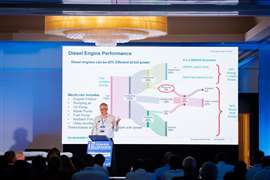 Deakin explaining the energy flow in a Sankey diagram for diesel engine efficiency in a genset working at 40 per cent efficiency. Photo: Joe Mather/KHL
Deakin explaining the energy flow in a Sankey diagram for diesel engine efficiency in a genset working at 40 per cent efficiency. Photo: Joe Mather/KHL
Engine efficiency
Using a 500 kVA generator running at optimum efficiency of 40 % (brake power at the crankshaft) gives about 400 kilowatts. There is 50 kilowatts of mechanical loss which is the same regardless of the load. Then there’s 600 kilowatts wasted in heat. “We’re basically burning fuel to make a thousand kilowatts, to get 400 kilowatts of useful energy out of it.”
Apply that to a tower crane application, where the engine is working at optimum efficiency but running at about 2.5 % average load. “In this case we end up with about 7 % useful power and 93 % is just turned into heat. Now go back to mechanical losses – they are now about 38 % of the energy in the fuel just overcoming engine friction and all those other things again.”
Most of the crank power gets turned into mechanical losses and an overall 7 % efficiency. Back to the 500 kVA generator and there are 10 kilowatts of useful work and 50 kilowatts of mechanical losses. Again, that’s the same number, and 140 kilowatts ends up coming out of the engine as waste heat.
If you think that is poor it can be even worse on EU Stage Five engines. “I’ve seen on building sites a 500 kVA generator with a 100 kilowatt load bank on it, and many of the generators have built-in [permanent] load banks as well. So now we’ve got 3 % useful work and the load bank is taking 28 %. We’re down at 3 % efficiency and 97 % of the energy in the fuel is just being turned into waste heat. The conclusion is that with EU Stage Five we can make efficiency a lot worse.”
What are the costs?
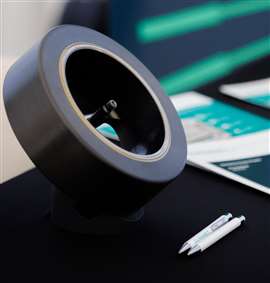 The flywheel from a Flybrid energy storage system. Photo: Joe Mather/KHL
The flywheel from a Flybrid energy storage system. Photo: Joe Mather/KHL
A 500 kVA EU Stage III A generator powering a large tower crane uses 15 litres of diesel an hour on average, for 60 hours per week. That’s 45,000 litres of diesel a year, or €67,500 at €1.50 a litre, and 120 tonnes of CO2. An equivalent Stage Five genset could use €200,000 in diesel.
Of the money spent on the fuel, just €4,500 of it is turned into energy to drive the crane. The remainder, a staggering €63,000, is wasted in heat. “The question then is how can we reduce that €63,000 of waste? If we had a diesel engine running at 40 % efficiency, that cost will reduce to €13,500 a year.”
For reference, if the crane was running on electricity from the mains, that would be about €7,500 a year for the same job.
How can diesel be used more efficiently? A 500 kVA generator, using 15 litres of fuel per hour, delivers us our 10 kilowatts, down at 5 to 10 % efficient, as mentioned earlier. If you use a transient device – a flywheel system which does peak lopping and helps the transients, or it could be super capacitors, the generator has to deal with the peak load for around 10 seconds but it also needs time to get to that peak load.
“We could replace the 500 kVA with a 200 kVA gen set plus a flywheel. That reduces our fuel consumption down to about seven litres an hour. Our brake power is still 10 kilowatts but we’ve pushed that efficiency curve up to 15 % efficient.
“If we go to a full power device, for example, a battery energy storage system, or a very large flywheel, where the system is basically charging from the generator at high efficiency, then we could drop that to, for example, a 25 kVA generator and battery, that’s consuming less than three litres of diesel an hour. The brake power is still 10 kilowatts but the efficiency’s been moved right into the region where we get the maximum efficiency from the engine.”
Battery and flywheel technology can significantly reduce the amount of fuel required to power the crane.
Big BESS and the grid
Now take another example, where there’s some mains electricity on the site for our five large tower cranes. If there was only 100 kVA of grid available one or two battery systems would do it but it would depend on a couple of things. “One is how quickly the battery responds because that battery has to protect the grid from the transients. We can’t put the full power onto the grid for short periods of time because it will just trip the grid breaker. We are probably going to end up needing to put one or two batteries and three generators on the site in this case.”
Big batteries contain a lot of lithium – lots of embedded CO2, and the parasitic loads can be 7 to 10 kilowatts. The Dumarey PowerSkid BESS can run from a 40 kVA mains supply, to power large tower cranes.
Or we can go for a right size battery. Again, we have 100 kVA grid available and we use some high power batteries. These are different in that they have a separate charging circuit which means the grid is isolated from the crane. The grid never sees the same load as the crane. With those a 20 kVA or 30 Amp, supply would be sufficient to power each of the tower cranes.
There we have five tower cranes running from 100 kVA rather than a 1 or 1.5 MVA supply. We’ve eliminated diesel from the site for powering tower cranes and there are other benefits. These batteries are quite small, so there’s much less lithium in there and less parasitic load. Low power mains can work, with the correct battery energy storage system to enable the site to be powered with the minimum of emissions. The technology here is the Revolution battery, which can work with a 10 or 20 kVA supply, and there’s less than 30 kilowatt-hours of batteries in each unit.
CO2 and cost
To summarise, mains is always going to be the best because it’s the lowest cost, you’re not burning lots of diesel and, as long as it’s on site, it’s there for free, and the CO2 is going to be the lowest.
Stage Five is going to be very expensive and up to around a hundred kilogrammes of CO2 per kilowatt-hour for the 10 kilowatts we’re going to use for this application.
With a flywheel and battery, we reduce the CO2 quite significantly, depending which technology you take. The small generator emits about 10 % of the CO2 compared to the Stage Five generator. There is a 90 % saving from doing that.
The flywheel and battery are slightly cheaper than the Stage III A generator. This solution is not going to cost you more money by putting the technology in place compared to the basic diesel generator everyone chose in the last few years.
All these solutions not only save CO2 they also save the end customer money.
Alternative fuels
In terms of alternatives to diesel there are numerous options, including: hydrogenated vegetable oil (HVO); hydrogen fuel cells; hydrogen internal combustion (IC); synthetic fuels; and Deakin’s colleagues at Dumarey in Italy work with TecnoGen to do a hydrogen IC generator with integrated flow.
Today, around 99 % of the hydrogen is still grey so that doesn’t help. If you’re burning HVO it is things like palm oil in there that is less environmentally friendly than you might think it could be. In addition, the cost can be relatively high and will remain so for a while.
If you’re going to use hydrogen, then maybe you have one truck delivery of diesel to your site once a week but that might be ten truckloads of hydrogen every week to be able to power those tower cranes.
It will be imperative to use alternative fuels efficiently. Using the BESS and the flywheels to optimise the efficiency will make the best use of those alternative fuels in the future. The same learning from diesel will always apply.
In a nutshell
Tower cranes, on average, have a power requirement of about 1 to 12 kilowatts. Generators operate at poor efficiency due to low load – five to 10 % for a Stage Three A and as low as 3 % for Stage Five. The mains grid results in the lowest cost and the lowest CO2 emissions.
Battery energy storage systems can enable small grids to power more cranes. New technologies combining flywheels and BESS can make it cheaper overall and reduce the CO2 by greater than 90 %. Alternative fuels will be able to get that last 10 % eventually. The first thing to do is to make sure that the 90 % target is achieved.
 Dr Andrew Deakin, technical director at Dumarey Green Power based in the UK
Dr Andrew Deakin, technical director at Dumarey Green Power based in the UK
About the speaker
Dr Andrew Deakin is technical director at Dumarey Green Power based in the UK. Dumarey develops and works with interesting technology, including flywheel energy storage, second life and new batteries, to make the operation of cranes and tower cranes in particular, more efficient. This article is derived from a presentation Deakin gave on the topic at the 2025 ITC conference in Rome.
STAY CONNECTED


Receive the information you need when you need it through our world-leading magazines, newsletters and daily briefings.
CONNECT WITH THE TEAM










